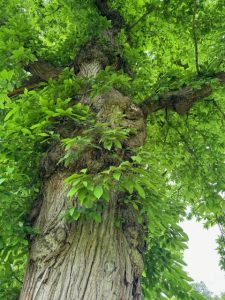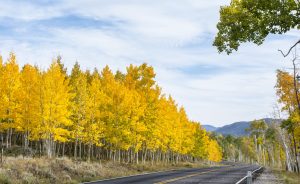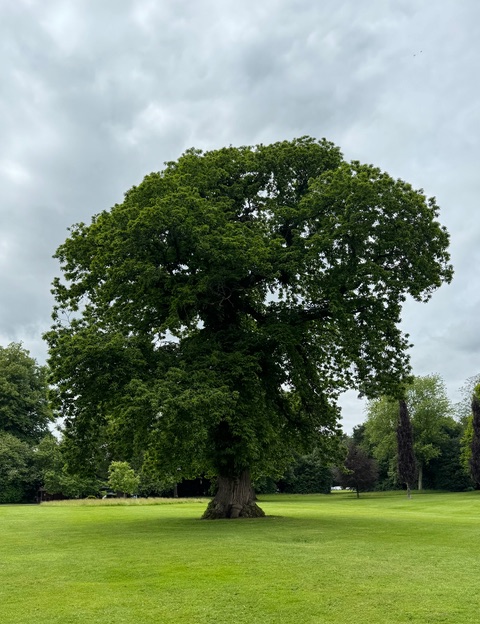by Christine Sine
Have you ever wondered what the tree of life in the garden of Eden really looked like? The commonest image we see is of an apple tree, but I wonder if it was more like the mother trees that we increasingly recognize as forest nodes, connecting extensively through mycelial filaments to surrounding trees. As Suzanne Simard explains in her book Finding the Mother Tree, sometimes an ancient mother tree is connected to hundreds of young saplings which they communicate with and help sustain through the fungal network that is part of the forest.
The Wood Wide Web is a busy network, where the fungal links serve as pathways for the back-and-forth transport of carbon, water, and nutrients among trees. Among the shifting dynamics of growing trees, the taller, replete, and illuminated elders can shuttle a net amount of resources along a source- sink gradient to shorter, shaded, understory trees. (Dr Suzanne Simard The Mother Project)
We tend to think of trees as individual units, but they are actually part of a large, interconnected community interacting with their own and other species, including forming kin relationships with their genetic relatives. I can imagine that the tree of life in the garden of Eden was like this, connected not just to other trees in the garden but to all the vegetation that made up the garden, sharing wisdom, encouraging growth and keeping healthy.

Giant oak Bowood house
In my recent trip to Britain I fell in love with the huge oak trees that dotted the landscapes in some of the parks we visited. They were part of my inspiration for this post. Some of them are more than three hundred years old. What disturbed me was that many of these trees stood in solitary splendour no longer a part of the great forests that once surrounded them. I suspect that some of them once formed part of the same kind of network that Dr Suzanne Simard documents in British Columbia. Maybe that fruit we were told not to eat in the garden of Eden wasn’t an apple but an acorn.
Oak trees once thrived across the whole of the Northern hemisphere. In California for example, their densely nutritious and neatly packaged, acorns provide a staple food source for deer, wild turkeys, squirrels, raccoons, rabbits, and dozens of bird species. Humans, too, have relied on them for over 4,000 years (4). California’s indigenous people dedicated much of their time to harvesting, processing, storing, and cooking acorns. Acorns were collected in the fall, leeched to remove bitter tannins, laid to dry in the sun, and stored in large granary baskets. Upon preparation, they were cracked out of their shells, peeled from the thin, paperlike skin around them, and pounded into a flour. The Tamyen Ohlone people of the Santa Clara Valley used this flour to make variations of mush, bread, or soup, which rounded out a nutritious diet of wild onion, carrots, blackberries, and trout. Today, oaks and their life-giving acorns are a sacred connection to history, culture, and sense of place for California’s native communities. (Mother Oak, Father Time)
Tragically oak trees, like many large trees are under attack, not just from humans but also from tiny but powerful creatures by the name of Phytophthora. While many species of Phytophthora affect and kill oaks, one of the most well known is Phytophthora ramorum, the pathogenic water mold that causes Sudden Oak Death (SOD). Some postulate that part of the reason for this increasing vulnerability is their isolation. Trees that are meant to be part of community don’t do well alone. Just like us. We are created to be part of community and don’t do well when we are isolated from each other. Social relationships and connections are one of the key factors that improve mental health and help us to age well.

Pando Aspen
One of the most fascinating giant trees in the world is in Utah. It is a one tree aspen forest called Pando which is believed to be the largest, most dense organism ever found at nearly 13 million pounds. The clone spreads over 106 acres, consisting of over 40,000 individual trees connected through one root system. The exact age of the clone and its root system is difficult to calculate, but it is estimated to have started at the end of the last ice age. Some of the trees are over 130 years old. It was first recognized by researchers in the 1970s and more recently proven by geneticists. Its massive size, weight, and prehistoric age have caused worldwide fame. It too is showing signs of decline. due to a lack of regeneration, along with insects and disease.
In Revelation 22: 1-5 we read about another giant tree, the tree of life in the New Jerusalem.
Then the angel showed me the river of the water of life, as clear as crystal, flowing from the throne of God and of the Lamb down the middle of the great street of the city. On each side of the river stood the tree of life, bearing twelve crops of fruit, yielding its fruit every month. And the leaves of the tree are for the healing of the nations. No longer will there be any curse.
This doesn’t sound like an apple tree to me, but more like the ultimate mother tree that gives life and nourishment to all creation. Such wonderful imagery of a giant interconnected forest network spreading throughout the city, providing both fruit and healing for everyone.
Is there a large grove of trees near where you live? Plan a visit. Sit in the midst of the trees for a while and read the imagery of the tree of life in Revelation several times. Imagine yourself sitting under God’s giant mother tree, as it pulsates with life and spreads that life out through the fungal filaments that connect it to all aspects of creation. Imagine picking fruit in every season, abundance all year round. No hunger season, no disease, no isolation. Everything connected, nourishing and protecting and providing for each other. What beautiful imagery for us to fill our day with today.

